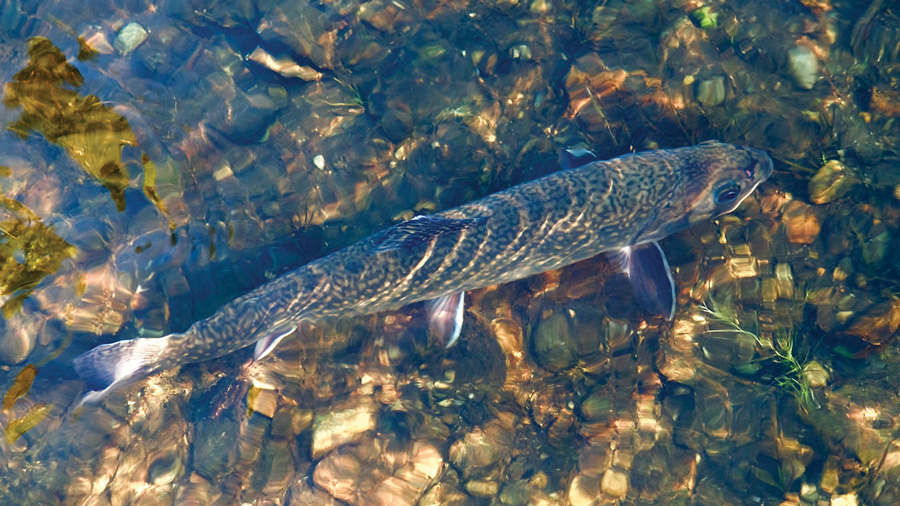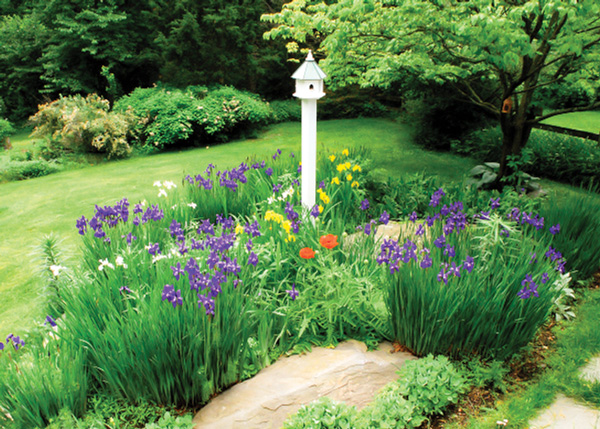By the time May draws to a close, the colorful regiment of tulips that flanks our drive is but a memory, as are the daffodils clustered along the edge of our woodlot. The hardwoods have leafed out, and in places it’s hard to find the sky. In Trish’s gardens, varying shades of iris are beginning to show. Azaleas have only recently lost their flowers while rhododendrons remain in full bloom.

Lilies, growing tall in June, are blooming as July approaches. High up in the trees, the buzz of cicadas fills the air. Chickadees, titmice, and finches have been replaced by bluebirds, phoebes and other birds known as flycatchers, whose principal diet consists of the insects that outnumber all of the earth’s other creatures. All through summer, wrens flit from the tops of birdhouses, posts, and poles. The trills and twitters of these tiny birds seem to come from every corner of our property as they feed their second, and sometimes third, broods. Hidden in the branches of bushes, catbirds chatter away.
As summer progresses, daisies bring a childlike cheerfulness to the fields alongside our country roads. Black-eyed Susans join them, followed closely by Queen Anne’s lace, with their delicate white flowers that remind me of the doilies my grandmother once placed on her table.
The summer months provide the newly born fawn, kit, and cub a brief respite from the dangers that make life so precious. Food is plentiful this time of year, and if all goes well, they can spend these few months learning valuable lessons taught by patient mothers.
Snakes luxuriate in the heat of summer. They can be found extended across garden paths and woodland trails, and especially over macadam that retains the heat. On more than one occasion, I’ve had to pull to the side of the road to wake a nine-foot black snake from its slumber.
The weekends are punctuated by the sound of lawn mowers and the smell of barbeque. With the right combination of sunlight and moisture, my garden will produce a bumper crop of vegetables while lemonade, Sangria, and beer will quench our thirst.

On Bonnie Brook, the sweet scent of wild rose replaces that of barberry and honeysuckle. Now and again, I take a break from casting my flies to snack on wild blackberries, raspberries, and red caps, but only after checking to be sure a black bear doesn’t have the same idea.
During summer, the trout of Bonnie Brook are hard to find. They spend their days in the deeper pools, retreating to undercut banks at the slightest sign of danger, sometimes hiding in plain sight while camouflaged by the dappled shade cast by the hardwood trees and those few hemlocks that remain standing.
A few years back, we had a sustained drought. Worried for the trout, I left my fly rod home. Walking beside the brook, I found that it had dried up in spots. Where once riffles fell into familiar pools, there was now an exposed streambed. Poking the cobble with my toe, I was startled when something between the pebbles stirred. I thought it might be a salamander or frog, but upon closer inspection discovered it was a brook trout that had wiggled under the damp stones to await the rain. I carefully backed away, wishing the little fish well, amazed at its resiliency. A summer rain, one that falls lightly, but throughout the day, will indeed refresh the brook—the awakened current once more filling the pools.
Mayflies and caddis form the trout’s principal food source. These aquatic insects live along the stream bottom, periodically rising to the surface, en mass, which is known as a hatch. Trout spend much of their time looking toward the bottom of the stream where these bugs can be found. However, when a hatch occurs, the fish will look upward, sometimes slashing the surface in a frenzied attempt to stuff their bellies.
Many years ago, I’d been fishing the brook, on a late afternoon in the middle of July. The air was still. Birdsong followed me as I waded downstream. I was wearing shorts under my hippers, and more than once stopped to dampen the neckerchief tied around my neck. I hadn’t seen a trout all afternoon. If I hadn’t known better, I would have thought the water was devoid of fish.
The deepest pool of Bonnie Brook can be found in its lower stretch, below a fall of water. The stream swings down through a steep gorge while flowing through a slate chute, dropping perhaps fifty feet into a hole. From there, it slides over a stone lip perhaps twenty feet wide that has been worn smooth over the years. The smooth stone extends downward for another ten feet, maybe more. Coursing over the stone, the current drops into a pool that is a few hundred feet around. The water in the pool is always oxygenated from the falling water while its depth allows fish to remain safe throughout the summer. It is the pool of my dreams.
Sitting on a log at the back of the pool, I’d decided to wait for the sun to go down. I’d read that during the summer, cooler water temperatures brought on by the setting sun could sometimes trigger a hatch. While seated, I watched a cedar waxwing take an insect on the wing. The bird flew over the pool and alighted beside a second bird perched on the branch of a tree that grew outward from the ravine above me. The second bird followed the example of the first, swinging out over the pool to take an insect too small for me to see.
As shadows deepened along the sides of the gorge, I listened to a thrush’s somber call. I was about to leave when a few caddis fluttered through the air. They looked like tiny helicopters. After a while, the little gray bugs began to skitter across the surface of the pool. I knew that these insects were returning to the stream to lay their eggs. Soon, other caddis started to rise from the stream bottom. I could see them drifting along with the current while some flew up into the air. It wasn’t long until the still of the evening was filled with this silent ballet. Caddis now filled the air. Some were rising up from the stream bottom while others flew down to drop their eggs.
It didn’t take long for the trout to take notice. I heard a splash at one end of the pool and then saw a fish erupt from the surface a few feet from where I had remained seated on the log. Another trout leaped clear out of the water in an attempt to capture one of the bugs that rose into the air.
It was becoming harder to see, although I could hear fish splashing as they filled their stomachs. Standing at the back of the pool, I measured my back cast so as not to tangle the line in the brambles that grew along the edge of the forest. I set the fly down at the base of the falls, but immediately lost sight of it in the growing darkness. A moment later I saw a flash of white as the maw of a very big trout opened and then closed around the helpless fly. I could feel the power of that fish when I pulled back on the bamboo rod. And then there was nothing. When I reeled in my line, I found that my fly was gone.
I returned the following night, but that’s a story for another day.